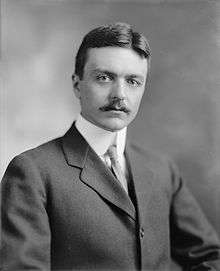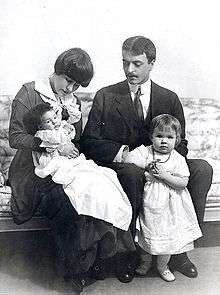Lathrop Brown
| Lathrop Brown | |
|---|---|
 Lathrop Brown in 1914 | |
| Born |
February 26, 1883 New York City, New York |
| Died | November 28, 1959 (aged 76) |
| Occupation | Real estate investor, politician |
| Spouse(s) | Hélène Hooper |
| Children | Halla, Camilla |
Lathrop Brown (February 26, 1883 – November 28, 1959) was a wealthy United States Representative from New York. Born in New York City, he graduated from Groton School in 1900 and from Harvard University in 1903, where he was roommates with Franklin Delano Roosevelt. He engaged in the real estate business and served in Squadron A of the National Guard of New York, for five years.
Government service
He was elected as a Democrat to the Sixty-third Congress (March 4, 1913 – March 3, 1915) and unsuccessfully contested the election of Frederick C. Hicks to the Sixty-fourth Congress. He was special assistant to the Secretary of the Interior from March 1917 to October 1918, and served as a private in the Tank Corps during the First World War. He was joint secretary of President Woodrow Wilson's Industrial Conference in 1919 and was a delegate to the Democratic National Conventions in 1920, 1924, and 1936. He studied monetary theory at the Graduate School of Harvard University from 1928 to 1932.
The family lived in a series of houses beginning on Long Island where Brown bought an 100-acre estate on St. James Harbor where they raised and raced horses. They commissioned Archibald Manning Brown to design a large, modern country house, although they never lived in it. (It's now known as the Knox School). While Brown served in Congress and as the assistant to the Secretary of Interior, they lived near the White House in Washington. They later moved to Manhattan, then The Windmill on Montauk Point, and Boston.[1][2]
Purchase of ranch in Big Sur

In 1924, Brown and his wife Hélène Hooper Brown, who at age 15 in 1910 inherited $10,000,000 and became an orphan at the same time, visited Big Sur, California, seeking some wild land on which they might build a house. They bought the Saddle Rock Ranch totalling 1,600 acres from pioneer homesteader Christopher McWay, and Julia Pfieffer Burns leased some land for cattle. Hélène became a good friend of Julia until Julia died in 1928.[3]
Build Waterfall House on coast
The Browns first built a redwood cabin on the cliffs across from McWay Falls, which at the time fell directly into the ocean. It was located where the Waterfall Overlook is today, but the location then and now is often shrouded by a marine layer of cold fog. The Carmel-San Simeon Highway was completed in 1937, and in 1940 the Browns constructed Waterfall House to replace the cabin. The multi-story house had a 16 foot wide marble staircase at its base and fine furnishings.
An ornamental brass fish, a large gold octopus with long tentacles, and a compass rose were inlaid in the entryway. They decorated the home with art by Degas, Dufy and Gauguin. Very large windows overlooking the Pacific Ocean. Hélène Brown's bedroom was the only room with a direct view of the waterfall. The small room was painted entirely black and had gold stars on the ceiling. One large window looked out on the falls. The bathroom adjacent to her bedroom was finished in a deep blue tile inlaid with gold, and mirrors were mounted and positioned to create endless reflections. Behind the house were terraced gardens and a caretaker's cottage.[3][4][5]
The house was sited about halfway down the cliff from the newly completed highway. To reach it, visitors boarded a short Funicular railway. It was a beautiful contemporary building, But the house experienced the same weather conditions as the cabin before it. The Browns wanted a home out of the fog's reach.[3][4]
First electricity on coast
Hans Ewoldsen, the Saddle Rock Ranch foreman, built a Pelton wheel on McWay Creek in 1932. He worked in the machine shop of the highway construction crew, using hand-split redwood from the canyon and other materials he bought. The undershot wheel ran a 32-volt generator and was the first electric power in the Big Sur area. It supplied power to three residences, a blacksmith shop, and the Funicular railway.[6]
Construct Tin House inland
In 1944, during World War II, they decided to build a house three miles inland on a ridge high above the fog. War-time rationing of vital supplies included building materials required some ingenuity. A side impact of the rationing was that gasoline was in short supply, forcing some gas stations out of business.[7]
The Browns saw opportunity in adversity and bought two abandoned gas station buildings. They selected a site on a ridge 1,960 ft (597m) above the coast. They had a road built, hired a crew to haul the tin gas station parts up the steep road, and paid an architect to assemble a home using the various parts of the two gas stations.[7]
When complete, the distinctive, modern house had bold lines. It had a kitchen, living room, and quarters for a maid. The family called it the Gas Station, although it later become known as Tin House. The home had spectacular views. The main windows in the large living room looked not out to sea but up and down the coast. A wall was constructed facing due west to block out the intense, direct rays of the afternoon sun. The living room was richly painted in blue. But despite the beautiful sights above the reach of the fog, legend has it that the Browns only spent one night in the new residence. They hadn't anticipated the metal siding and roof expanding and contracting with the day-time heat and night-time cold, and the noisy popping and creaking that accompanied it. After a sleepless night, they never returned.[8]
Brown was elected to the sheriff's posse of Monterey County in 1947. Visitors to Big Sur might encounter a rumour that Tin House was built as a vacation getaway for President Franklin D. Roosevelt. The truth is that Lathrop Brown and Franklin Roosevelt were childhood friends and each other's best man when they married. But FDR never visited the Tin House.[7][7]
Lathrop and Hélène left Big Sur for Florida in 1956 where Lathrop died in 1959. In 1961 Hélène Hooper Brown donated the entire property to the state, stipulating that it be used as a park and named for her good friend, Julia Pfeiffer Burns, "a true pioneer." She included the requirement that Waterfall House be converted into a museum within five years to house Big Sur history, otherwise that it be razed. For several reasons this was not accomplished and the mansion was demolished in 1966. The Waterfall Overlook of McWay Falls was built on that spot. Visitors to the site today can view the remnants of the home's landscaping, including palm trees. The Pelton wheel is on display as well.[1]
Later life
Brown was a member of a committee to supervise the Graduate School of Public Administration of Harvard University in 1954 and 1955. He died in Fort Myers, Florida and was cremated; the ashes were interred in Abbey of the Light, Manasota Memorial Park, Sarasota, Florida. His home at Nissequogue, New York, known as Land of Clover, was added to the National Register of Historic Places in 1993.[9]
References
- 1 2 Grossman, Pam Canfield. "Lathrop Brown, Long After Harvard". The Franklin Delano Roosevelt Foundation. Retrieved 28 July 2016.
- ↑ "Lathrop Brown, Political Dilettante". Retrieved 28 July 2016.
- 1 2 3 Canright, Anne (Summer 1997). "Waterfall Trail on Big Sur" (PDF). California Coast and Ocean. California Coastal Conservancy and the California Academy of Sciences. 13 (2). Retrieved 28 July 2016.
- 1 2 "House with a View". Historical Marker Database. Retrieved 28 July 2016.
- ↑ "McWay Waterfall Trail". HikingBigSur.com.
- ↑ "Julia Pfeiffer Burns State Park". California Department of Parks and Recreation. Retrieved 28 July 2016.
- 1 2 3 4 Almanzan, Krista. "The Myth and Mystery of the Tin House". The California Report. Retrieved 28 July 2016.
- ↑ Henson, Paul (December 10, 1996). The Natural History of Big Sur (paperback ed.). University of California Press. p. 355. ISBN 978-0520205109. Retrieved 28 July 2016.
- ↑ National Park Service (2009-03-13). "National Register Information System". National Register of Historic Places. National Park Service.
- United States Congress. "Lathrop Brown (id: B000937)". Biographical Directory of the United States Congress.
| United States House of Representatives | ||
|---|---|---|
| Preceded by Martin W. Littleton |
Member of the U.S. House of Representatives from New York's 1st congressional district 1913-1915 |
Succeeded by Frederick C. Hicks |